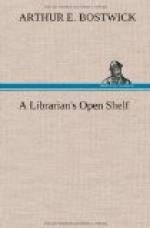While Sorolla is painting a group of children on the beach, I may take a kodak picture of the same group. My photograph may be a better likeness than Sorolla’s picture, but it has no art-value. Why? Because it was made mechanically, whereas Sorolla put into his picture something of himself, making it a unique thing, incapable of imitation or of reproduction.
The man who has a message, one of those pervasive, compelling messages that are worth while, naturally turns to art. He chooses his subject not as an end, but as a vehicle, and he makes it speak his message by his method of treatment, conveying it to his public more or less successfully in the measure of his skill.
We have been speaking of the representative arts of painting and sculpture, but the same is true of art in any form. In music, not a representative art, in spite of the somewhat grotesque claims of so-called program music, the method of the composer is everything, or at least his subject is so vague and immaterial that no one would think of exalting it as an end in itself. There is, however, an art in which the subject stands forth so prominently that even those who love the art itself are continually in danger of forgetting the subject’s secondary character. I mean the art of literature. Among the works of written speech the boundaries of art are much more ill-defined than they are elsewhere. There is, to be sure, as much difference between Shelley’s “Ode to a Skylark” and Todhunter’s “Trigonometry” as there is between the Venus de Milo and a battleship; and I conceive that the difference is also of precisely the same kind, being that by which, as we have seen above, we may always discriminate between a work of art and one of utility. But where art-value and utility are closely combined, as they are most frequently in literature, it is, I believe, more difficult to divide them mentally and to dwell on their separate characteristics, than where the work is a concrete object. This is why we hear so many disputes about whether a given work does or does not belong to the realm of “pure literature,” and it is also the reason why, as I have said, some, even among those who love literature, are not always ready to recognize its nature as an art, or mistakenly believe that in so far as its art-value is concerned, the subject portrayed is of primary importance—is an aim in itself instead of being a mere vehicle for the conveyance of an impression.
Take, if you please, works which were intended by their authors as works of utility, but have survived as works of art in spite of themselves, such as Walton’s “Compleat Angler” and White’s “Natural History of Selborne.” Will anyone maintain that the subject-matter of those books has much to do with their preservation, or with the estimation in which they are now held? Nay; we may even be so bold as to enter the field of fiction and to assert that those fictional works that have purely literary value are loved not for the story they tell, but for the way in which the author tells it and for the effect that he thereby produces on the reader.




